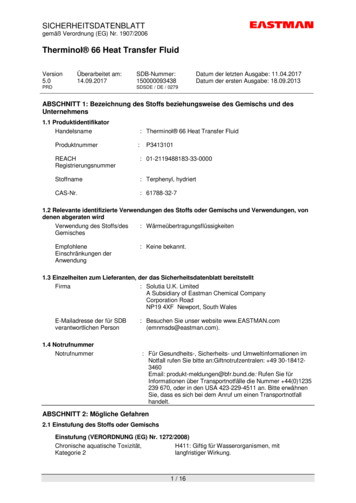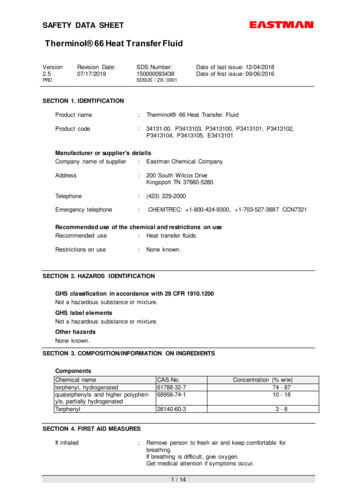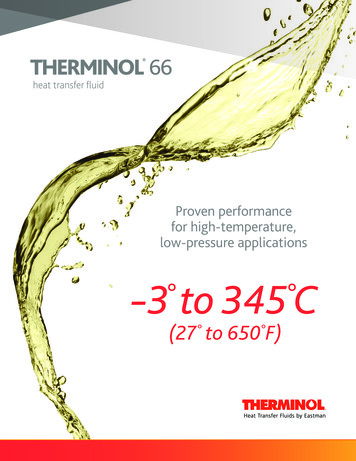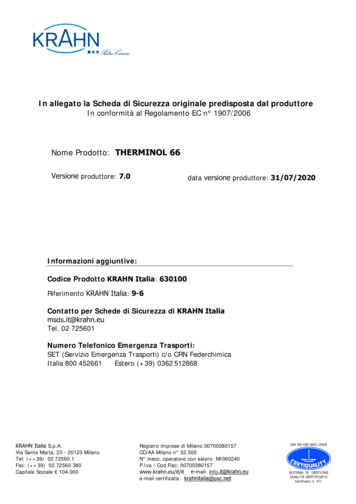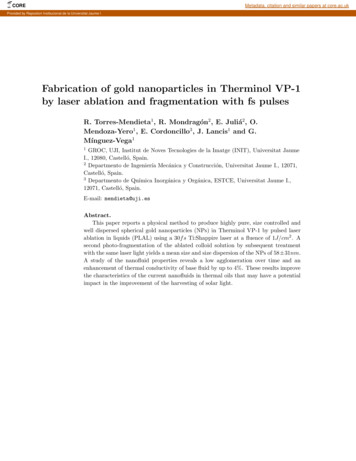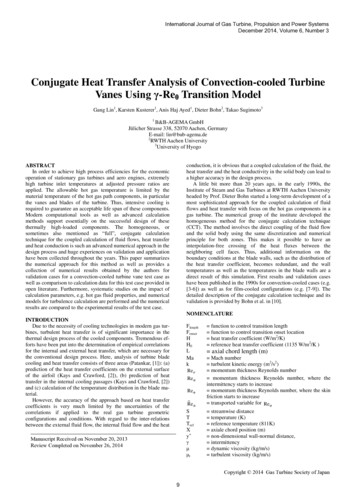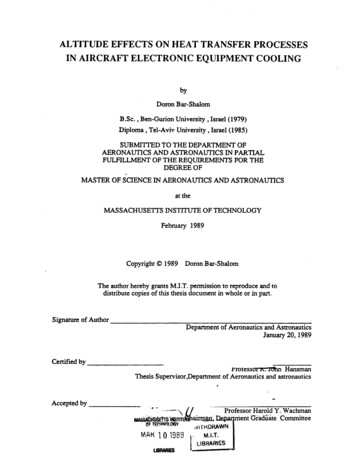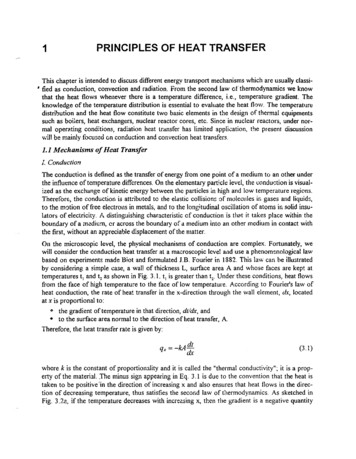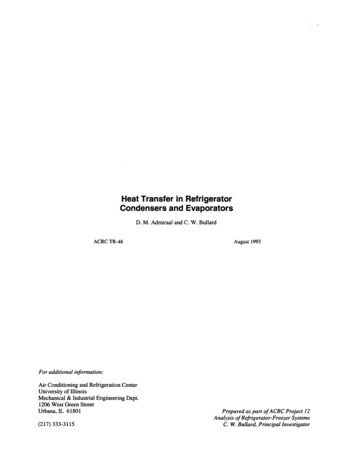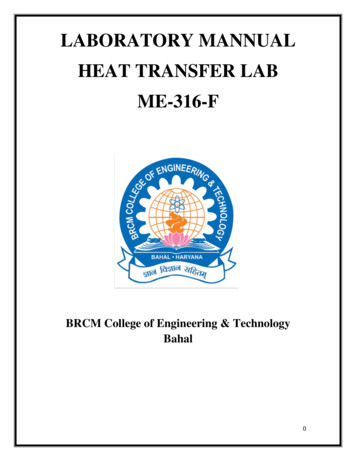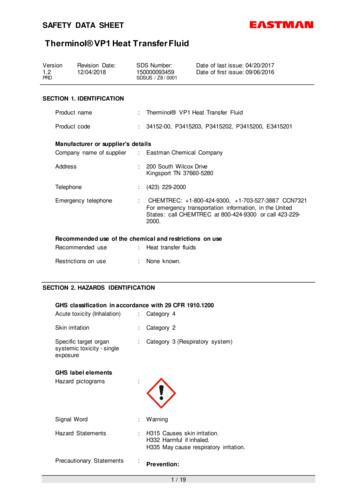
Transcription
SAFETY DATA SHEETTherminol VP1 Heat Transfer FluidVersion1.2Revision Date:12/04/2018PRDSDS Number:150000093459Date of last issue: 04/20/2017Date of first issue: 09/06/2016SDSUS / Z8 / 0001SECTION 1. IDENTIFICATIONProduct name:Therminol VP1 Heat Transfer FluidProduct code:34152-00, P3415203, P3415202, P3415200, E3415201Manufacturer or supplier's detailsCompany name of supplier: Eastman Chemical CompanyAddress:200 South Wilcox DriveKingsport TN 37660-5280Telephone:(423) 229-2000Emergency telephone:CHEMTREC: 1-800-424-9300, 1-703-527-3887 CCN7321For emergency transportation information, in the UnitedStates: call CHEMTREC at 800-424-9300 or call 423-2292000.Recommended use of the chemical and restrictions on useRecommended use: Heat transfer fluidsRestrictions on use:None known.SECTION 2. HAZARDS IDENTIFICATIONGHS classification in accordance with 29 CFR 1910.1200Acute toxicity (Inhalation): Category 4Skin irritation:Category 2Specific target organsystemic toxicity - singleexposure:Category 3 (Respiratory system)GHS label elementsHazard pictograms:Signal Word:WarningHazard Statements:H315 Causes skin irritation.H332 Harmful if inhaled.H335 May cause respiratory irritation.Precautionary Statements:Prevention:1 / 19
SAFETY DATA SHEETTherminol VP1 Heat Transfer FluidVersion1.2Revision Date:12/04/2018PRDSDS Number:150000093459Date of last issue: 04/20/2017Date of first issue: 09/06/2016SDSUS / Z8 / 0001P261P264P271P280Avoid breathing dust/ fume/ gas/ mist/ vapors/ spray.Wash skin thoroughly after handling.Use only outdoors or in a well-ventilated area.Wear protective gloves.Response:P302 P352 IF ON SKIN: Wash with plenty of soap and water.P304 P340 P312 IF INHALED: Remove person to fresh airand keep comfortable for breathing. Call a POISONCENTER/doctor if you feel unwell.P332 P313 If skin irritation occurs: Get medical advice/ attention.P362 Take off contaminated clothing and wash before reuse.Storage:P403 P233 Store in a well-ventilated place. Keep containertightly closed.P405 Store locked up.Disposal:P501 Dispose of contents/ container to an approved waste disposal plant.Other hazardsNone known.SECTION 3. COMPOSITION/INFORMATION ON INGREDIENTSIngredientsChemical namediphenyl oxideBiphenyl; diphenylCAS-No.101-84-892-52-4Concentration (% w/w)73.526.5SECTION 4. FIRST AID MEASURESIf inhaled:Remove person to fresh air and keep comfortable forbreathing.If breathing is difficult, give oxygen.Consult a physician if necessary.In case of skin contact:Wash off immediately with soap and plenty of water whileremoving all contaminated clothes and shoes.If skin irritation occurs: Get medical advice/ attention.Wash contaminated clothing before reuse.In case of eye contact:In case of contact, immediately flush eyes with plenty of waterfor at least 15 minutes.Get medical attention if symptoms occur.If swallowed:IF SWALLOWED: Immediately call a POISONCENTER/doctor.Do NOT induce vomiting.Rinse mouth.2 / 19
SAFETY DATA SHEETTherminol VP1 Heat Transfer FluidVersion1.2Revision Date:12/04/2018PRDSDS Number:150000093459Date of last issue: 04/20/2017Date of first issue: 09/06/2016SDSUS / Z8 / 0001Never give anything by mouth to an unconscious person.Most important symptomsand effects, both acute anddelayed:Causes skin irritation.Harmful if inhaled.May cause respiratory irritation.SECTION 5. FIRE-FIGHTING MEASURESSuitable extinguishing media:Water sprayCarbon dioxide (CO2)Dry chemicalFoamUnsuitable extinguishingmedia:Do not use a solid water stream as it may scatter and spreadfire.Hazardous combustion products:Hazardous decomposition products due to incompletecombustionCarbon oxidesFurther information:Use a water spray to cool fully closed containers.Do not allow run-off from fire fighting to enter drains or watercourses.This product is not classified as a fire-resistant heat transferfluid. Precautions to avoid sources of ignitions should betaken.Special protective equipmentfor fire-fighters:Wear an approved positive pressure self-contained breathingapparatus in addition to standard fire fighting gear.SECTION 6. ACCIDENTAL RELEASE MEASURESPersonal precautions, protec- :tive equipment and emergency proceduresVentilate the area.Avoid breathing dust/ fume/ gas/ mist/ vapors/ spray.Avoid contact with skin and eyes.Material can create slippery conditions.Wear appropriate personal protective equipment.Local authorities should be advised if significant spillagescannot be contained.Environmental precautions:Clear up spills immediately and dispose of waste safely.Avoid release to the environment.Collect spillage.Methods and materials forcontainment and cleaning up:Contain spillage, soak up with non-combustible absorbentmaterial, (e.g. sand, earth, diatomaceous earth, vermiculite)and transfer to a container for disposal according to local /national regulations (see section 13).Prevent runoff from entering drains, sewers, or streams.SECTION 7. HANDLING AND STORAGE3 / 19
SAFETY DATA SHEETTherminol VP1 Heat Transfer FluidVersion1.2Revision Date:12/04/2018PRDSDS Number:150000093459Date of last issue: 04/20/2017Date of first issue: 09/06/2016SDSUS / Z8 / 0001Advice on safe handling:Do not breathe vapors or spray mist.Handle product only in closed system or provide appropriateexhaust ventilation at machinery.In case of insufficient ventilation, wear suitable respiratoryequipment.Keep away from flames and sparks.Wear appropriate personal protective equipment.Avoid contact with skin, eyes and clothing.Wash thoroughly after handling.Wash contaminated clothing before reuse.Drain or remove substance from equipment prior to break-inor maintenance.Handle in accordance with good industrial hygiene and safetypractice.Conditions for safe storage:Store locked up.Keep container tightly closed in a dry and well-ventilatedplace.Keep in a cool place away from oxidizing agents.SECTION 8. EXPOSURE CONTROLS/PERSONAL PROTECTIONIngredients with workplace control parametersIngredientsCAS-No.diphenyl oxide101-84-8Value type(Form ofexposure)TWA (Vapor)STEL (Vapor)TWA (Vapor)TWA (Vapor)Biphenyl; diphenyl92-52-4TWATWATWATWAEngineering measures:Control parameters / Permissibleconcentration1 ppm2 ppmBasis1 ppm7 mg/m31 ppm7 mg/m30.2 ppm0.2 ppm1 mg/m30.2 ppm1 mg/m30.2 ppm1 mg/m3NIOSH RELACGIHACGIHOSHA Z-1ACGIHNIOSH RELOSHA Z-1OSHA P0Good general ventilation (typically 10 air changes per hour)should be used. Ventilation rates should be matched toconditions. If applicable, use process enclosures, localexhaust ventilation, or other engineering controls to maintainairborne levels below recommended exposure limits. Ifexposure limits have not been established, maintain airbornelevels to an acceptable level.Personal protective equipmentRespiratory protection:Use a properly fitted, particulate filter respirator complyingwith an approved standard if a risk assessment indicates this4 / 19
SAFETY DATA SHEETTherminol VP1 Heat Transfer FluidVersion1.2Revision Date:12/04/2018PRDSDS Number:150000093459Date of last issue: 04/20/2017Date of first issue: 09/06/2016SDSUS / Z8 / 0001is necessary.Respirator selection, use, and maintenance must be inaccordance with regulatory requirements, if applicable.If engineering controls do not maintain airborneconcentrations below recommended exposure limits (whereapplicable) or to an acceptable level (in countries whereexposure limits have not been established), an approvedrespirator must be worn.Hand protectionRemarks:Wear suitable gloves. When handling hot material, use heatresistant gloves.Eye protection:Wear safety glasses with side shields (or goggles).Skin and body protection:Wear suitable protective clothing.Protective measures:Ensure that eye flushing systems and safety showers arelocated close to the working place.Hygiene measures:Handle in accordance with good industrial hygiene and safetypractice.SECTION 9. PHYSICAL AND CHEMICAL racteristicOdor Threshold:not determinedpH:not determinedMelting point/range:54 F / 12 CBoiling point/boiling range:495 F / 257 C(1,013 hPa)Flash point:230 F / 110 CMethod: Pensky-Martens closed cup255 F / 124 CMethod: Cleveland open cupEvaporation rate:not determinedSelf-ignition:1150 F / 621 CMethod: ASTM D21555 / 19
SAFETY DATA SHEETTherminol VP1 Heat Transfer FluidVersion1.2Revision Date:12/04/2018PRDSDS Number:150000093459Date of last issue: 04/20/2017Date of first issue: 09/06/2016SDSUS / Z8 / 0001Vapor pressure:not determinedRelative vapor density:not determinedRelative density:1.06 (77 F / 25 C)Density:1,060 kg/m3 (77 F / 25 C)Solubility(ies)Water solubility:0.025 g/lPartition coefficient: noctanol/water:Not applicableAutoignition temperature:not determinedDecomposition temperature:not determinedViscosityViscosity, dynamic:not determined:2.48 mm2/s (104 F / 40 C)Viscosity, kinematic0.99 mm2/s (212 F / 100 C)Explosive properties:Not classifiedOxidizing properties:Not classifiedSECTION 10. STABILITY AND REACTIVITYReactivity:None reasonably foreseeable.Chemical stability:Stable under normal conditions.Possibility of hazardous reactions:None known.Conditions to avoid:Heating in air.Keep away from flames and sparks.Incompatible materials:Strong oxidizing agentsHazardous decompositionproducts:Emits acrid smoke and fumes when heated to decomposition.SECTION 11. TOXICOLOGICAL INFORMATIONAcute toxicityHarmful if inhaled.Product:6 / 19
SAFETY DATA SHEETTherminol VP1 Heat Transfer FluidVersion1.2Revision Date:12/04/2018PRDSDS Number:150000093459Date of last issue: 04/20/2017Date of first issue: 09/06/2016SDSUS / Z8 / 0001Acute oral toxicity:LD50 Oral (Rat): 2,050 mg/kgAssessment: May be harmful if swallowed.Acute inhalation toxicity:LC50 (Rat, Male and Female): 2.66 mg/lExposure time: 4 hTest atmosphere: dust/mistAssessment: Harmful if inhaled.Acute dermal toxicity:LD50 Dermal (Rabbit): 5,010 mg/kgAssessment: Not classifieddiphenyl oxide:Acute oral toxicity:LD50 Oral (Rat, female): 2,830 mg/kgAcute inhalation toxicity:LC50: Remarks: No data availableAcute dermal toxicity:LD50 Dermal (Rabbit, Male and Female): 7,940 mg/kgAcute oral toxicity:LD50 Oral (Rat, male): 2,180 mg/kgAssessment: The component/mixture is minimally toxic aftersingle ingestion.Acute inhalation toxicity:LC50 (Rat, male and female): 3.47 mg/lExposure time: 1 hAssessment: The substance or mixture has no acute inhalation toxicity::::Rabbit24 hCauses skin bitslightSpecies:HumansIngredients:Biphenyl; diphenyl:Skin corrosion/irritationCauses skin irritation.Product:SpeciesExposure timeAssessmentResultIngredients:diphenyl oxide:SpeciesExposure timeResultBiphenyl; diphenyl:7 / 19
SAFETY DATA SHEETTherminol VP1 Heat Transfer FluidVersion1.2Revision Date:12/04/2018PRDSDS Number:150000093459Date of last issue: 04/20/2017Date of first issue: 09/06/2016SDSUS / Z8 / 0001AssessmentResult::Irritating to skin.strongSerious eye damage/eye irritationNot classified based on available information.Product:SpeciesResultExposure timeAssessment::::RabbitNo eye irritation24 hNot classifieddiphenyl oxide:SpeciesResultExposure timeAssessment::::Rabbitcorneal opacity4hirritatingResult:slight to moderateBiphenyl; diphenyl:SpeciesResult::Rabbitslight ritating to eyes.Ingredients:Respiratory or skin sensitizationSkin sensitizationNot classified based on available information.Respiratory sensitizationNot classified based on available information.Product:Remarks:No data availableTest TypeSpeciesAssessmentMethodResult:::::Skin SensitizationGuinea pigNot classifiedOECD 406: Guinea pig sensitizationnon-sensitizingTest TypeSpecies::Human experienceHumansIngredients:diphenyl oxide:8 / 19
SAFETY DATA SHEETTherminol VP1 Heat Transfer FluidVersion1.2Revision Date:12/04/2018PRDSDS Number:150000093459Date of last issue: 04/20/2017Date of first issue: 09/06/2016SDSUS / Z8 / 0001AssessmentMethodResult:::Not classifiedHuman Repeat Insult Patch Testnon-sensitizing::::OECD 406: Guinea pig sensitizationGuinea pigNot classifiedDoes not cause skin sensitization.Biphenyl; diphenyl:Test TypeSpeciesAssessmentResultGerm cell mutagenicityNot classified based on available information.Product:Genotoxicity in vitro:Test Type: Salmonella typhimurium assay (Ames test)Metabolic activation: /- activationMethod: Bacterial Reverse Mutation AssayResult: negativeTest Type: Chromosome aberration test in vitroMetabolic activation: /- activationMethod: In vitro Mammalian Chromosome Aberration TestResult: negativeGenotoxicity in vivo:Test Type: Mammalian Erythrocyte Micronucleus TestSpecies: MouseMethod: Mammalian Erythrocyte Micronucleus TestResult: negative:Test Type: Salmonella typhimurium assay (Ames test)Metabolic activation: /- activationMethod: Bacterial Reverse Mutation AssayResult: negativeIngredients:diphenyl oxide:Genotoxicity in vitroTest Type: Mutagenicity - MammalianMetabolic activation: /- activationMethod: In vitro Mammalian Cell Gene Mutation TestResult: negativeTest Type: Mutagenicity - MammalianMetabolic activation: /- activationMethod: In vitro Mammalian Chromosome Aberration TestResult: negativeTest Type: Mutagenicity - MammalianMetabolic activation: /- activationMethod: OECD Guideline 482Result: negative9 / 19
SAFETY DATA SHEETTherminol VP1 Heat Transfer FluidVersion1.2Revision Date:12/04/2018PRDSDS Number:150000093459Date of last issue: 04/20/2017Date of first issue: 09/06/2016SDSUS / Z8 / 0001Biphenyl; diphenyl:Genotoxicity in vitro:Test Type: Salmonella typhimurium assay (Ames test)Metabolic activation: /- activationMethod: Bacterial Reverse Mutation AssayResult: negativeTest Type: Mutagenicity - MammalianMetabolic activation: activationMethod: In vitro Mammalian Cell Gene Mutation TestResult: positiveTest Type: Chromosome aberration test in vitroMetabolic activation: /- activationMethod: In vitro Mammalian Chromosome Aberration TestResult: negativeTest Type: Mutagenicity - Mammalian
Therminol VP1 Heat Transfer Fluid Version 1.2 PRD Revision Date: 12/04/2018 SDS Number: 150000093459 SDSUS / Z8 / 0001 Date of last issue: 04/20/2017 Date of first issue: 09/06/2016 1 / 19 SECTION 1. IDENTIFICATION Product name : Therminol VP1 Heat Transfer Fluid Product code : 34152-00, P3415203, P3415202, P3415200, E3415201 Manufacturer or supplier's details Company
